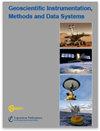用于抑制瞬态电磁系统中极低频无线电的优化混合门控方案
IF 2.3
4区 地球科学
Q3 GEOSCIENCES, MULTIDISCIPLINARY
Geoscientific Instrumentation Methods and Data Systems
Pub Date : 2024-02-13
DOI:10.5194/gi-13-27-2024
引用次数: 0
摘要
摘要测量地表下电阻率最广泛使用的方法之一是瞬态电磁法(TEM)。然而,来自不同来源(如无线电通信、仪器、大气和电力线)的噪声和干扰会严重干扰这些类型的信号。其中,3 至 30 千赫之间的甚低频(VLF)无线电传输是最主要的噪声源之一。瞬态电磁信号通常采用门控技术来提高信噪比。需要精确选择栅极形状,以抑制不需要的噪声,同时允许 TEM 信号不发生改变地通过。我们采用多目标粒子群优化技术,通过最小化由标准误差条、门间协方差和门控信号失真组成的目标函数,选择最佳门控形状和位置。所提出的方法既适用于完全采样的合成 TEM 数据,也适用于箱车门控的现场数据。从门阵列形状的搜索空间中发现,最佳输出是箱车门阵列和汉明门阵列的混合组合。通过对协方差矩阵和误差条的分析,证实了混合门控比传统的箱车门控和半锥形门控更有效。结果表明,所开发的方法能有效抑制中间门(即中心时间跨度为 30 至 200 µs 的门)和晚期门(即中心时间跨度为 200 至 1130 µs 的门)的 VLF 噪声。分析表明,在合成数据和现场数据中,混合门控方案比箱式门控方案的平均标准误差分别提高了 1.719 和 1.717。本文章由计算机程序翻译,如有差异,请以英文原文为准。
An optimized and hybrid gating scheme for the suppression of very low-frequency radios in transient electromagnetic systems
Abstract. One of the most widely used approaches for measuring the earth's subsurface resistivity is the transient electromagnetic (TEM) method. However, noise and interference from different sources, e.g., radio communication, the instrument, the atmosphere, and power lines, severely taint these types of signals. In particular, radio transmission in the very low-frequency (VLF) range between 3 and 30 kHz is one of the most prominent sources of noise. Transient electromagnetic signals are normally gated to increase the signal-to-noise ratio. A precise selection of gate shapes is required to suppress undesired noise while allowing the TEM signal to pass unaltered. We employ the multi-objective particle swarm optimization technique to choose optimal gate shapes and placements by minimizing an objective function composed of standard error bars, the covariance between gates, and the distortion of the gated signal. The proposed method is applied to both fully sampled synthetic TEM data and to boxcar-gated field data. The best output from the search space of gate shapes was found to be a hybrid combination of boxcar and Hamming gates. The effectiveness of hybrid gating over traditional boxcar and semi-tapered gating is confirmed by an analysis of covariance matrices and error bars. The results show that the developed method effectively suppresses VLF noise in the middle gates, which are gates with center times spanning 30 to 200 µs , and in the late gates, which are gates with center times spanning 200 to 1130 µs. The analysis shows that the average improvement in standard errors obtained for the hybrid gating scheme over boxcar gating is 1.719 and 1.717 for synthetic and field data, respectively.
求助全文
通过发布文献求助,成功后即可免费获取论文全文。
去求助
来源期刊

Geoscientific Instrumentation Methods and Data Systems
GEOSCIENCES, MULTIDISCIPLINARYMETEOROLOGY-METEOROLOGY & ATMOSPHERIC SCIENCES
CiteScore
3.70
自引率
0.00%
发文量
23
审稿时长
37 weeks
期刊介绍:
Geoscientific Instrumentation, Methods and Data Systems (GI) is an open-access interdisciplinary electronic journal for swift publication of original articles and short communications in the area of geoscientific instruments. It covers three main areas: (i) atmospheric and geospace sciences, (ii) earth science, and (iii) ocean science. A unique feature of the journal is the emphasis on synergy between science and technology that facilitates advances in GI. These advances include but are not limited to the following:
concepts, design, and description of instrumentation and data systems;
retrieval techniques of scientific products from measurements;
calibration and data quality assessment;
uncertainty in measurements;
newly developed and planned research platforms and community instrumentation capabilities;
major national and international field campaigns and observational research programs;
new observational strategies to address societal needs in areas such as monitoring climate change and preventing natural disasters;
networking of instruments for enhancing high temporal and spatial resolution of observations.
GI has an innovative two-stage publication process involving the scientific discussion forum Geoscientific Instrumentation, Methods and Data Systems Discussions (GID), which has been designed to do the following:
foster scientific discussion;
maximize the effectiveness and transparency of scientific quality assurance;
enable rapid publication;
make scientific publications freely accessible.
 求助内容:
求助内容: 应助结果提醒方式:
应助结果提醒方式:


